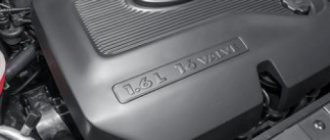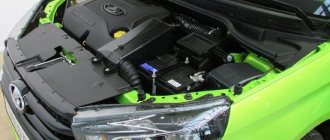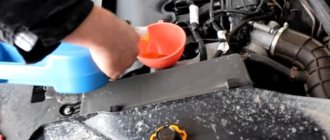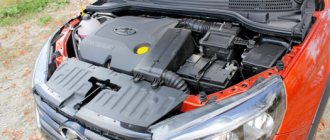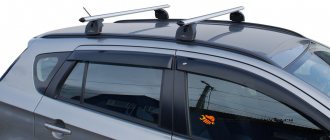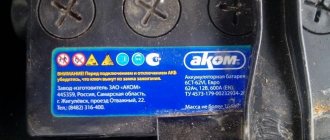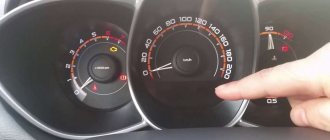Not much time has passed since the start of sales of new products from the domestic automobile industry, but tuning enthusiasts have already begun to work on improving the car. Tuning Lada Vesta SV Cross is a series of activities aimed at improving the car. Namely, external styling, which affects the exterior of the car. For example, installing non-standard body kits or new rims. In fact, external tuning of the Lada Vesta SV Cross is most often aimed at improving the appearance. Such tuning has virtually no effect on speed characteristics. However, for deep customization of the car, external styling can also contribute. For example, a properly selected body kit improves not only the appearance, but also has a positive effect on aerodynamic characteristics. And lightweight rims affect the handling and acceleration of the car. Therefore, external tuning of a car does not always make changes only to the appearance.
In addition to the usual tuning of the exterior, you can also work on the interior. For example, a regular interior re-upholstery will not affect performance in any way. In general, in the interior of the Lada Vesta SV Cross there is a whole expanse for tuning. For most people, tuning means installing a powerful audio system or soundproofing a car. For people involved in motorsports, tuning the interior is to make it as light and strong as possible. Often all plastic, seats, and panels are completely thrown out of the interior. Instead of the driver's seat, a sports bucket is installed, and instead of the instrument panel, special sensors are installed. To prevent deformation of the body during an accident, a special safety cage is installed in the cabin - bolted or welded.
Updated Lada Vesta SW Cross
was released in June 2022. It has not yet been restyled, since it practically did not differ from the original conceptual model. In addition to the station wagon, the SW Cross version was also presented.
The new product is distinguished by modified bumpers; there are plastic linings along the perimeter of the body. The exhaust pipe has a chrome-plated nozzle; the basic version is equipped from the factory with 17-inch wheels. Instead of drum brakes, disc brakes are installed at the rear and front.
The SV Cross is also distinguished by an antenna in the shape of a shark fin and a gas tank lid that opens with a button. At the customer’s request, the car can be painted in the exclusive “Mars” color.
A dashboard with white backlight appeared in the cabin, and a courtesy lamp was installed above the rear sofa. In front, between the seats, there is an armrest, behind which there is a socket, a USB port, and a button for turning on the rear seat heating. The latter function has not previously been used in any other Lada model. The SW Cross version differs from the regular station wagon by having orange inserts in the interior design.
Dimensions of the cross-station wagon:
- length – 4410 mm;
- width – 1764 mm;
- height – 1532 mm;
- wheelbase – 2635 mm;
- ground clearance - 203 mm;
- trunk volume – 480 l.
Overall dimensions of the car The trunk volume increases to 825 liters by folding the rear sofa in a ratio of 60:40. If previously the trunk lid was opened with a key, now it can be done with a button. Under the mat is an organizer with a minimal set of tools and a jack, and immediately below them is a full-size spare tire. The trunk is additionally equipped with special devices for securing cargo, lighting and another 12 V socket.
Under the hood of the SV Cross is a power unit with a capacity of 126 hp. With. with a working volume of 1.8 liters.
There is no basic configuration as such; the Cross version is sold only in the maximum configuration:
- four airbags;
- ESP system (stabilization and directional stability);
- light and rain sensors;
- rear view camera with parking assistant;
- climate control;
- electric windows front and rear;
- heated front and rear seats;
- heated windshield and rear window;
- Cruise control;
- alloy wheels R17;
- central locking.
Additionally, you can order the “Multimedia” option, which includes navigation and cameras. The “Prestige” option will add an armrest to the rear sofa, atmospheric interior lighting and tinting of the rear hemisphere.
Enhanced tuning of Lada Cross - all innovations
For each motor, a certain limit is set on its maximum capabilities and resource. Let's say the standard 1.8-liter Vesta SV Cross engine can produce no more than two hundred, maximum two hundred and thirty horsepower. However, with such a resource the engine will travel no more than several thousand kilometers. If the driver does not have enough power, but does not want to shorten the life of the engine, it is better to try using an engine from another car and install it in a sports Lada. To see how to do this and which power unit to choose, just go to Utube.
There are many videos here about installing pumped engines in regular cars. What does this procedure lead to? First of all, the owner will be able to obtain the necessary resource. If, according to the manufacturer, the motor is designed for a power of up to three hundred horses, do not forget about the resource reserve.
Related link:
Choosing the color of a Lada Vesta car: review of model shades
The power of the power unit will increase, but it can also be modified. But the biggest disadvantage of this procedure is the complex installation of a new motor, the need for competent and thorough calculations and a professional approach to work. Separately, it is worth highlighting the difficulties in connecting and setting up a new motor.
External styling spoiler, bumper and door sills
Tuning Vesta, in our opinion, begins with visual changes. It is more pleasant to see and feel the changes first than to feel them while actually driving the car. Fortunately, the body kit of the domestic Lada Vesta costs adequate money. We would start refining the interior with yarplast, we are tired of the constantly dirty coating, but here we just wipe it with a rag - it shines. Rear tuning for the Lada Vesta bumper involves installing Xmug, there is the same bumper in front, together they look harmonious. Recently, sedans from VAZ have begun to please with their appearance - Vesta is direct proof. It’s far from ideal, it requires a lot of work on styling and on the engine, but it’s a level higher than what it was before. The appearance of the body is acceptable, I just want to see a trim, sporty look. It will suit the average user, but there is no tuner. We think it is necessary to change the front bumper. It’s too boring and there’s also a rook in the middle.
But what to do when the standard tuning of the Lada Vesta SV Cross is no longer enough?
Undoubtedly, any motor has its own resource and maximum. For example, from a standard 1.8 Lada Vesta SV Cross engine you can squeeze out 200-230 hp. But the life of such an engine will last for several thousand km... Maybe more, if you're lucky. In order to avoid such a situation, you don’t have to reinvent the wheel and build a new motor, but install a new one, but from a different car. Projects are now gaining popularity on YouTube, where auto bloggers install an already pumped up engine in simple cars. What do we get as a result? Firstly, we get the resource we need so much. Agree, if an engine is designed for 300 hp or more, then it is made with a reserve of service life. Secondly, we get an increase in power and a new field of activity - now you can tune a new engine.
But there are also disadvantages. One of the most serious is the difficulty of installation. Everything needs to be calculated correctly and installed correctly. You will also need to connect and configure everything, which is also an initially complex process. But we do tuning, and we don’t hang stinkers on mirrors. So? Therefore, we can do anything.
Improving the salon
Well, we're done with the exterior, let's move on to the interior. There are many more questions about the interior than about the appearance. The main problems are impracticality due to materials and sound insulation. In general, Vesta tuning cannot be imagined without modifications to the interior. It's like painting the outside of a house but leaving everything old inside. By the way, what we wouldn’t touch in the cabin is the dashboard. It’s well made, simple, and most importantly intuitive. A million light bulbs, sensors, etc. don’t get in the way.
The most necessary things in the panel are visible, even a mark at a speed of 100 km/h so that the driver does not violate the speed limit. A basic armrest will work for the first time, but I would recommend replacing it, it’s inexpensive and makes life much easier. Returning to the impractical interior, I recommend purchasing and installing rubber pads on the carpet. This simple procedure will in the future save you from wasting effort on interior cleaning and dry cleaning. Sound insulation would be improved to the maximum. On Vesta there is insulation, but not yet enough to say “like on a foreign car.”
Pedals
By default, the pedal pads on the Lada Vesta are made of rubber. Moreover, the quality of the rubber is far from the best, even in the Comfort and Luxury configurations.
The vast majority of car owners practice installing pedal pads from Lada XRAY. In addition to domestic accessories, linings from Opel Astra and Ford Focus are compatible.
| Name | Cost, rub.) |
| 9218000388 (metal, rubber) | From 2180 |
| 9218000288 —/— | From 2761 |
| AP0650AP80 (wear-resistant rubber) | From 2500 |
| 9215000188 XRAY | From 2400 |
| 9215000088 (plastic) | From 1100 |
| AR85-1108010 (chrome edging) | From 2600 |
*prices are current as of 11/12/18.
Pedal option
Pedal option 2
Pedal option 3
Tuning the Lada Vesta interior
The following changes concern the interior, the modernization of which can significantly transform the Lada Vesta car. Tuning and modifications in this case are done according to taste and color. As a rule, the ceiling in the cabin is reupholstered and many elements are painted in the color of the body. You can also replace the gearshift knob, seats (or covers), install pedal covers and tint the windows.
Another popular and relatively inexpensive tuning of the Lada Vesta interior is the installation of various LED lamps (diodes) in different parts of the interior of the car. Agree, it’s very nice when, when you get into a car, the mat and doorways are illuminated in your favorite color. Many car enthusiasts even attach garlands to the car interior - but here it is worth understanding that this distraction affects driving safety.
Lada Cross - brake tuning
To improve the performance of the braking system, professionals advise tuning the brakes. This is most often done by installing larger brake discs and brake pads with increased rigidity. Sometimes discs already have ventilation and perforation.
Even if you simply replace standard brake discs with larger ones, this will have a positive effect on the functionality of the car’s braking system. Of course, this is not enough to make the entire system much more efficient. To achieve better results, it is proposed to install a sports braking system in a comprehensive manner.
The cost of such a modification is far from low, because a sports braking system is much more expensive than a standard one. Experts assure that you cannot skimp on brakes, and it is advisable to start tuning the Lada Cross with them. Traffic safety depends on this.
Related link:
Lada Vesta SV and Lada Vesta SV Cross. What is the fundamental difference and which is better to choose?
The main disadvantages of the Lada Vesta SV that can be corrected
Vesta SW is the car that Russian drivers have been waiting for so long. But initially it turned out to have quite a lot of problem areas and shortcomings. Naturally, taking radical measures, the automaker corrected most of them. But the drivers themselves have something to work on.
There are some nuances that you will have to work on yourself:
The first thing you need to pay attention to is the cabin air intake. It is located in front of the windshield under the windshield
Its huge disadvantage is that it is absolutely not covered with anything - there is no mesh or other structures on the rectangular hole that could trap debris and leaves. As a result, everything ends up in the filter, and it quickly becomes clogged. Some craftsmen solve this by installing a homemade frame with a mesh made from a plastic window. The frame itself is cut from an ordinary plastic motor oil canister. Over time, the front panel begins to rattle and creak while driving. In this case, the problem lies in the instrument cluster wells, mounts, housings, wires, mounting blocks, air ducts, trim, and so on. Some Vesta owners solve the problem with the help of special anti-squeaking products, which can be purchased at car stores. Naturally, you will have to work hard - you will need to disassemble half of the front part of the cabin and treat all places with this product, tighten the casings and bolts. Often there are uneven gaps between the body and the hood. Sometimes they are very large, so they interfere with opening it or disable the lock. You will have to fix it yourself by adjusting the stop and lock. You will most likely need to use a file. The factory does not install branded hood gas struts, but dealers have them. But how necessary this is is for everyone to decide for themselves. The fuel filler door does not lock and there is no protection in the filler neck. The only thing that will help here is to buy a plug with a key. The ideal option would be a model from Logan. In the rear door, water penetrates into the wiring harness block in the area of the hole for the guide strip. You will have to remove the cover, use a rag or soft washer and mastic around the guide. Then everything is installed in place.
Another feature of the model is that all modifications have ABS, but not all have a button to turn it off. When overcoming mud or deep snow, the electronics will simply “strangle” the engine, and as a result the car will get stuck. In this case, there is only one solution - temporarily disable the system. To do this, disconnect the fuse in the mounting block or the connector of the speed sensor of one of the wheels.
It is also noted that wires and hoses under the hood often fray. To protect them, you should stock up on electrical tape and clamps. The first to suffer is the rubber hose, which over time rubs against the plastic corrugation on the engine shield. Also, other wires and hoses constantly rub against the decorative engine cover. In addition, sometimes the lid itself rattles, and this is eliminated using gaskets or plastic plugs that are installed under the plastic.
Conclusion
Vesta - since its appearance, it has become the object of desire of many Russian drivers. But everything turned out to be not as smooth as the manufacturer promised. Many problems have been fixed, but some will have to be dealt with on their own. Thanks to tuning, you can “tailor” the car to suit you. Yes, it takes time and money. In addition, some modifications may lead to loss of warranty and reliability of the machine. But on the other hand, you will get a more comfortable Vesta with greater capabilities. Therefore, whether to do tuning or not is your purely personal decision. Although sometimes this is more a necessity than a desire to show off.
Why do many people talk about chip tuning?
In fact, chip tuning is on everyone's lips. Some people have a positive attitude towards it, while others completely reject this practice. However, the opportunity to quickly and inexpensively add a few horsepower to your Vesta, and also make the engine more flexible, responsive and economical, tempts many.
Many Vesta owners have already gone through this procedure and, as a rule, write in their reviews that the car actually drove better, at the same time listing other advantages. But is everything so clear?
The popularization of chip tuning is greatly facilitated by the mass of examples of engines (not only from VAZ, but also from other companies), which, with the same technical data, are able to produce different power indicators, and they can fluctuate within the range of 5-20 hp. With.
Despite the fact that Vesta has only been on sale for about a year, there are many chip tuning offers for this model.
Interior tuning
A standard tuning kit to improve the interior usually includes the following parts:
- Door cards;
- Headlining;
- Dashboard trim;
- Seat Covers;
- Rugs;
- Rack covers;
- Steering wheel.
But, given that the Lada Vesta looks quite modern, it practically does not need modifications to the interior.
Basically, on more modern cars, tuning is carried out only when the owner wants to give the overall appearance of the interior his own original style. There is no particular point in changing anything individually. On the Lada Vesta “Standard” and “Norma” versions, you can replace the steering wheel with a more universal one, with additional acoustic control buttons. You can also replace the seat covers with ones that are more beautiful in appearance. At this point, the improvement of the interior can be completed.
How to modify Vesta
Modifications can be made for any car.
And when we talk about a Russian manufacturer, many sigh and claim that in this case even global events will not produce results. However, the owners of the brand new Vesta do not always agree with this - they have proven by their own example that the new AVTOVAZ product is quite good and can become even better. By making a number of modifications, you can get a car with better characteristics, it will be more comfortable and interesting.
History of restyling
The new Lada Vesta went on sale in 2015. The improved model was different from previously sold cars. Manufacturers carried out the next restyling two years later. These two updates were carried out in order to improve the car - technically and to correct shortcomings. Thanks to this, it was possible to correct the existing shortcomings:
— tapping in the rear suspension area when driving, or not corrected;
— steering wheel grinding in rainy weather;
— the appearance of scratches when lowering the windows;
— modification of clutch wheels;
— sound insulation of the interior space has been improved.
The Lada Vesta was last updated in 2022.
What kind of chip tuning are we talking about?
It is worth understanding that high-quality and large-scale chip tuning, which will provide a truly significant increase in power, is only possible with mandatory intervention in the design of Vesta engines. In this case, it means replacing the “hardware” - camshafts, pistons, intake and exhaust components, etc. Naturally, all this comes with new ECU firmware.
However, this option is not suitable for sedan owners, because the price will be simply excessive and, together with the cost of work, will easily exceed 50,000, or even 80,000 rubles.
For this reason, when it comes to chip tuning of Vesta, it means updating the firmware in the model’s ECU, without interfering with the mechanical part. But the decision in favor of such chip tuning is fraught with not only advantages. In addition to the advantages, there are also disadvantages. Therefore, it is also necessary to consider the risks and be prepared for the consequences.
Engine modifications
The Vesta line offers three power units, two 1.6 liters and one 1.8 liter 87/106/122 hp. With all options, there will be no problems for a specialist. The process is quite long, but the result will please you. The main idea is chip tuning of the engine and installation of different camshafts. This will significantly increase power from 106 hp to 177 hp. Installing LGS and STI camshafts makes it possible to increase dynamics without changing speed. The car becomes more dynamic.
Related link:
Side mirrors of Lada Vesta.
Some owners note that the electronic pedal sometimes works slowly, so they are advised to modify it themselves. For different modifications, the solution to the problem will be different. In one case, you will need to slightly file the travel limitation protrusion, and in the second, you will need to tighten the location of the cover.
Interior
The fact that the Skoda has passed the European New Car Assessment Program (Euro NCAP) test, while another competitor has not, makes it extremely safe. However, beyond the official crash test results, there are other things we need to know about.
Salon Skoda Rapid
Both cars belong to the small family car segment, which tends to classify them somewhere in the middle in terms of safety, but that doesn't help us solve our dilemma? Additionally, when it comes to weight, a factor that most people underestimate, the Russian car offers a marginal difference of 1%!more metal.
The dashboard is identical to the earlier Rapid, which in turn is shared with the VW Vento. The design is subdued, but everything is where you'd expect. The centerpiece is the new large and fairly clear 6.5-inch touchscreen with USB, AUX and Bluetooth support, as well as MirrorLink connectivity. Other new equipment includes rain-sensing wipers and electronically folding outside mirrors, which help bridge the gap between the Rapid and better-equipped rivals. Skoda's trademark 'smart features' come in the form of a card holder clip on the center console that stores all your passes and the like.
Frontal visibility for rear passengers is also not the best due to the large front seats. However, the presence of front and rear armrests, unlike the Vesta, is welcome. Other notable equipment includes tilt and telescopic steering, auto-dimming rearview mirror, cruise control, cooled glove compartment, climate control, rear air vent, one-touch power windows and remote windows. However, some features are noticeably missing, such as a rearview camera and an engine start/stop button.
Lada Vesta salon
Speaking of safety, Skoda offers ABS and dual front airbags as standard on all versions of the new Rapid. You also get roll control and electronic stability control with the DSG transmission. Skoda has a bad reputation when it comes to sales, but they have come a long way in making the process transparent and reliable. The car also makes less noise and has better insulation. They also offer a 4-year vehicle servicing program as standard with the new Rapid, which covers 4 years of warranty, 4 years of roadside assistance and an optional 4-year service package.
| Lada Vesta | Skoda Rapid | |
| 2016 | Production | 2017 |
| C | Car class | C |
| Station wagon, 5 doors | Body type | Hatchback, 5 doors |
| Front | Drive unit | Front |
| 4424 mm. | Length | 4483 mm. |
| 1785 mm. | Width | 1706 mm. |
| 1537 mm. | Height | 1461 mm. |
| 480 liters | Trunk (min.) | 550 liters |
| 825 liters | Trunk (max.) | 1490 liters |
| 55 liters | Fuel tank | 55 liters |
| Petrol | Fuel | Gasoline/diesel |
| 4 - Inline, 4 valves per cylinder | Configuration | 4 - Inline, 4 valves per cylinder |
| Naturally aspirated. | Aspiration | Turbo |
| 1774 cc cm. | Volume | 1598 cc |
| 122 l. With. | Power | 115 l. With. |
| 170 Nm | torque | 250 Nm |
| mechanics, 5 gears | mechanics, 5 gears | |
| 1310 kg. | Vehicle weight | 1295 kg. |
| 11.2 s. | Acceleration 0-100 km/h | 10.0 s. |
| 180 km/h | Maximum speed | 201 km/h |
| 10.7 l/100 km | Consumption in the city | 4.7 l/100 km |
| 6.4 l/100 km | Highway consumption | 4.0 l/100 km |
| 7.9 l/100 km | Mixed consumption | 4.2 l/100 km |
| 169 g/km | CO2 emissions | 109 g/km |
| automatic, 5 gears | automatic, 6 gears | |
| 1330 kg. | Vehicle weight | 1265 kg. |
| 13.3 s. | Acceleration 0-100 km/h | 11.8 s. |
| 180 km/h | Maximum speed | 190 km/h |
| 10.1 l/100 km | Consumption in the city | 10.2 l/100 km |
| 6.3 l/100 km | Highway consumption | 6 l/100 km |
| 7.7 l/100 km | Mixed consumption | 7.5 l/100 km |
| US$11,200 | Price from | US$15,100 |
We recommend: Hyundai Porter 2 truck
Chip tuning for Vesta from Paulus
The chip tuning itself from Paulus involves one of the options for changing parameters in the Vesta engine ECU. The goal is to optimize various characteristics - ignition angle, fuel supply and others.
In addition, the use of firmware from Paulus guarantees the possibility of removing the catalyst, without consequences for the power unit, since tuners can turn off the catalyst control sensor (in accordance with the client’s wishes).
Chip tuning from Paulus provides increased acceleration dynamics, increases traction in the mid-speed range and reduces Vesta's consumption. According to the studio, all programs developed by them are tested on benches, and Paulus himself has extensive experience in creating programs for ECUs.
Photos of graphs and changes in characteristics:
Thin line - stock firmware;
Thick line - tuning firmware;
Green lines - power in hp;
Blue lines - torque in Nm.
Door trim
The Lada Vesta has one characteristic feature that needs to be taken into account when upgrading - the door card is non-separable, one-piece. You won’t be able to simply insert a “piece” of leather: either the standard equipment, or a solid upholstery of material.
Despite the fact that the wrapping process is not complicated, craftsmen recommend that it be carried out exclusively at a service station. If you decide to reupholster yourself, then act according to the recommendations of specialists.
The rear row of the door card is fixed in a similar way. The number of plastic clips is twice as large. In all other respects, the dismantling process is similar.
Sheathing stage-1 Inside view Sheathing stage-3 Final view
General tuning Vesta SV
In terms of general tuning, Vesta, like many other cars, gives you the opportunity to go wild. If you have the desire, time, opportunity and money, then you can radically change your car by performing the following operations:
- installing linings, deflectors, racks, protection, spoilers;
- carry out tuning of the power unit, interior, brakes, body, transmission, suspension;
- replacing the seat upholstery
- by reducing the brightness of the standard MMC backlight and so on.
But to start changing something, it’s worth figuring out whether there is any point in certain modifications. When working with a sedan, you can change its appearance by replacing the installed bumper with the Vesta Xmug model. From the front it will become more aggressive and sporty, this does not interfere with driving even on bad roads, so it is a practical and very interesting option. The cost of modification is about 5.5 thousand rubles. You can increase the practicality of a car with the help of yarplast type door sills, the cost of which starts from 650 rubles. Installing them makes cleaning the machine easier. For many drivers, improving optics is a must, as is installing 18-inch wheels.
But these are all fairly simple solutions. But more radical changes require a serious approach:
- Door sill, bumper and external styling spoiler. The main changes here are only visual. The body kit costs adequate money, but you need to start with yarplasts. Installation of Xmug bumpers makes the appearance of the model even more interesting and vibrant.
- Working with the salon. There are many more questions here than with appearance. Poor sound insulation and impractical materials constantly remind of themselves. The fewest questions arise about the dashboard. Many people recommend replacing the base armrest right away, but it is inexpensive. It is better to install rubber pads on the carpet.
- Turbine. This cannot be done without technical improvements. Without such tuning, all changes will be incomplete. The first thing you need to do is install the turbine; here you will need to contact specialists to install the part and configure the option. It is recommended to purchase a complete kit at once.
Finally, you can work on the exhaust system, but this is only for those who love the “animal roar”. By removing the catalyst, the sound becomes bright and aggressive. But sometimes it is necessary to work with the system if the exhaust “howls”. This indicates that the corrugation has deteriorated and a resonator with a reinforced element will need to be installed. And the spider exhaust manifold will help make the sound as pleasant as possible.
Tuning modification Lada Vesta Cross SW
Vesta Cross is the most interesting option from the entire line. Tuning will improve ride quality, comfort, appearance and generally remake the car to suit you, making it truly unique. But it is important to remember that during modifications the machine may suffer a little, the warranty will be voided and reliability will be lost. For example, when chipping an engine, up to 10% of its service life can be lost. And the work itself can cost up to 150 thousand rubles.
In the “cross” version it is possible to increase the ground clearance. If 203 mm of ground clearance is not enough for you, then you need to make some minor modifications. You can install special spacers – metal plates – under the racks. This will give you a few extra centimeters. It should be noted that different spacers are used for the front and rear struts. You can also reduce the ground clearance using a shortened suspension, in which shock absorbers and springs have been developed. But you won’t be able to cut the springs yourself, since a different suspension design is used.
One of the most popular types of tuning is the development of the “brains” and the engine. Often, reflashing is resorted to due to many shortcomings in the program, however, in more recent models, many of them have been eliminated by the manufacturer. But even after reprogramming such cars, they drive completely differently. Replacing the manifold also helps improve performance. Instead of the standard one, a “spider” is installed, but the Euro compliance indicators drop from the fifth level to the second. In addition, ringing often occurs due to the thin metal of the part, so it is wrapped with thermal tape, but this does not completely solve the problem. As a result, the car starts easier, performs better and becomes more dynamic.
Related link:
License plate illumination on a Lada Vesta car.
Main differences
In reality, the cars are very similar, especially when it comes to interior and exterior design. Virtually no changes in the interior. All the main differences relate to technical characteristics, equipment and price.
Salon design and interior
There are also differences in design. Cross models are distinguished by the fact that on the sills, arches and bumpers there is a plastic body kit with protection from scratches and chips. An individual bright orange has appeared in the color line, like the “cross Kalina”. What both models have in common are roof rails on which a luggage rack can be attached. Another detail of the image is the decorative nozzle on the exhaust pipe.
The interior has many almost identical parts, but there are many interesting solutions that make the “cross” version stand out. The interior of the new product is made more interesting and brighter, and all thanks to the decorative trim. At the same time, there are additional options, the installation of which is not provided for on the SV. However, all decorative differences can be ordered separately on the SV.
The main differences in the cabin are as follows:
- original interior lighting;
- light and rain sensor;
- use of combined eco-leather and fabric in seat upholstery;
- heated windshield;
- the inscription on the dashboard Cross;
- LED lighting in the front doors and interior;
- decorative bright inserts;
- use of climate control.
In all other respects, there are no differences in the interior of both models. In general, all the differences in the interior are only that the decorative parts are made in the color of the body.
Difference in car sizes
Naturally, both modifications are very similar in appearance. But there is a certain difference regarding the dimensions. So “Cross” is a little longer, wider and higher (4424x1785x1532) than “SV” (4410x1764x1512). At the same time, the mass did not change - 1280-1350 kg. The ground clearance has also been increased, which is 203 mm compared to the previous 178 mm.
Luggage compartment differences
The luggage compartment volume in both models is 480 liters, which is average for station wagons. The useful volume could be larger, but it is reduced by an organizer with various shelves and niches that are used to store various small things. The organizer is convenient for neatly arranging, securing and transporting small loads.
However, if you need to transport large items, then it will be completely useless. In general, it takes up quite a lot of free space and raises the floor.
To really get the full claimed 480 liters you will need to remove this organizer.
Suspension, transmission, price
The changes also affected the wheels; in the modified version they put 205/50 R17, and in the regular model they offer 195/55 R16 and 185/65 R15. In the rear suspension of the SW, they installed station wagon springs, which are 9 mm larger than those of the sedan, the Cross has completely different springs and shock absorbers, the suspension settings have been changed, and the track has become wider by 14 mm, the suspension has been retuned
The choice of transmission for the Cross is smaller than in the SW. For the city station wagon, the manufacturer offers 4 transmission options – 2 manual and 2 automatic. The “cross” version does not have a 1.6 liter engine option with a robotic transmission. In other words, the regular version is offered with a range of four engines, while the all-terrain model offers only three.
It’s not surprising that the Cross is more expensive than the regular SV version. If you don’t want to overpay and you are quite satisfied with the characteristics of the city version, then you can purchase it for 640 thousand rubles, and the maximum price tag will be 805 thousand rubles. But the price for the “cross” version starts at 756 thousand rubles. and reaches 848 thousand rubles.
Tuning optics for Lada Vesta
This VAZ tuning option has become very popular in recent years. New headlights or building lights can dramatically change the appearance of a car, especially at night. Many analogues of the original lights are manufactured at Russian and foreign (usually Chinese) factories. Giving your car individuality in this way is one of the best tuning options at a low cost. Tuning headlights on a Lada Vesta will not take much of your time and effort, and the result will constantly please you.
If you want to understand in more detail how to make high-quality tuning of the Lada Vesta, videos and photos, which abound on the Internet, will help you with this. You can choose for yourself the most optimal option for upgrading your car.
Reviews
| Positive | Negative |
| I live in a small village. The roads are far from ideal, and in winter snow removal is also difficult. Vesta Cross has never let me down in three years. | I wanted an inexpensive SUV, so I fell for the domestic manufacturer and its Cross SV. It turned out I just wasted my money - higher taxes, more expensive consumables. And for the city, as for me, it’s not the best option - fuel consumption is higher. It seems to me better to take a sedan or just an SV. |
| In the summer we often go to the dacha, first on asphalt, and then on a dirt road with large puddles. The ground clearance is very pleasing - the car copes with large irregularities quite easily. Good weight distribution made the car stable on the track. | I thought it was a real SUV, but it turned out to be an ordinary city SUV. All year round I go hunting, fishing, and pick mushrooms in the forest. In general, even Cross is powerless for our taiga. (The verse turned out :-))) |
| I use the car only to take my child to school, go shopping and visit. I like everything, so far there are no comments. Convenient, beautiful, everything works well. | My partner and I purchased identical models at almost the same time. Engine capacity 1.8 l. In the end, everything is fine with him, but I constantly add oil to mine. |
| I don’t understand why so many people criticize Vesta. I bought a car a little over a year ago and everything is fine. I drive carefully, change all consumables on time, and don’t spare money on fluids. During all this time I did not have a single serious problem. The only negative I think is poor sound insulation. | When starting abruptly, it behaves inappropriately. The car begins to shake - not much, but unpleasant. The car is only six months old and now these problems have started. I can’t figure out what’s wrong, and I can’t send it for service right now. I'm afraid other problems will arise. |
| The car is about six months old, and I decided to do chip tuning. Fell in love with her again. She became more playful and dynamic. | Terrible plastic that is poorly secured. Any unevenness on the road gives off a nasty creaking sound. I had to contact the service and spend money to do at least something about it. |
Related link:
Thresholds on Lada Vesta
Bottom line
Budget method: leave the handles “as is” or install accessories from the Lada Vesta Comfort, Luxury equipment.
| Name | Cost, rub.) |
| Accessories from Lada Vesta Comfort, Lux | From 550 |
| —/— | —/— |
| —/— (chrome inserts) | From 700 |
| Blank on the wings | From 250 |
| Cover fabric | From 550 |
| —/— skin | From 900 |
*prices are current as of 11/12/18.
Ceiling
With the ceiling upholstery, everything is extremely simple - leather, Alcantara (suede) if available, Alcantara-like fabric as a budget option.
| Name | Cost (rub.) / linear meter |
| Leather | From 450 – 700 |
| Alcantara | From 500 |
| Leather substitute | From 350 |
| Textile | From 250 |
| Fabric material 1 – 1.5 mm thick | From 200 |
| —/— 1.5 – 2.0 | From 250 |
*prices are current as of 11/12/18.
Console
Most often, the dashboard is reupholstered with Nappa eco-leather. Each person chooses the color of the stitching individually, depending on the main color of the machine. Alcantara and genuine leather are used, but extremely rarely due to impracticality, soiling, and difficulty in maintenance.
| Name | Cost (rub.) / linear meter |
| Leather | From 500 – 900 |
| Alcantara | From 550 |
| Leatherette | From 450 |
| Textile | From 200 |
*prices are current as of 11/12/18.
The cost of atelier (workshop) services is negotiated individually.
Original Option with orange color
Styling the appearance of Lada Vesta SW
For typical external styling, it is common to carry out a number of procedures. Plastic trims can be mounted on the door, luggage compartment or roof. There are many different options for such decorative elements. This includes a spoiler, protective trim for side panels, deflectors for hoods, and much more. The owner can choose a kit that includes extensions for wheel arches and side doors. Often, owners install wheels with a large diameter and stylish rims.
A distinctive detail of the external modification can be a number of exclusive boots. The popularity of tinting, both full and partial, is noted; in addition, many install tuning on rear or front optics. The approximate cost of improvements is presented in the table:
Related link:
LADA Vesta SV Cross – colors and shades
| Cost of standard black mudguards | 1,200 rubles |
| Price for protection for front bumpers | 550 rubles |
| Price of rear bumper covers | 1,200 rubles. |
| Cost of gas struts for hoods | 2,500 rubles |
| Spoiler installation | From 3 to 5 thousand |
| Installation of LED optics | 15 thousand rubles |
| Installing a roof rack | From 2 to 5 thousand |
| Cost of disks | From 3 thousand |
